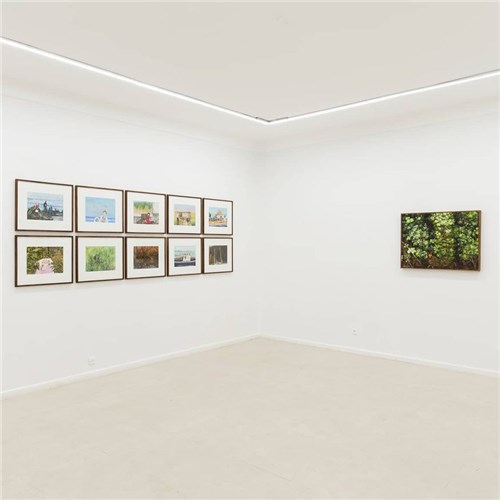Delgoshagallery proudly presents the third solo exhibition by Niaz Babatabar, titled“Seyyed Mostafa Garden”.
The people of Boroujerd are considered to be the most gregarious tribe in Iran. They named their city “Cypressville” and built structures among the city’s gardens and cypress trees. Broujerdians had given a new meaning to ‘free-living’. They revered the importance of a human’s accessibility to beauty; so much so that they went against the laws of ‘Baq-e Irani’ (Iranian gardens) and often built the structure in the most aesthetically pleasing part of the garden. In some instances, they would even build a smaller garden within the house as well as ponds or pools. They named these structures “Takaya”. These gardens were kept their beauty, as no walls were built around them and roses or cypresses declared the borders of the garden instead, which left the area as pristine as it was. Moreover, in keeping with the tradition of genius Iranian architects, they would use the resulting shade of this wall of trees during the day. Boroujerdians had truly built heaven on earth for themselves.///
Seyed Mostafa garden belonged to the painter’s grandfather and it was built in a “Takaya” in Boroujerd during the first Pahlavi regime. The painter has no recollection of the excitement associated with that era and can only satisfy her Iranian romanticism with documented memories and photographs, although she is still preoccupied with that family. A family who are drinking like sailors at an inn (Seyed Mostafa garden) when suddenly the door opens and a messenger offers them treasure (i.e. more pleasure) and invites them to travel and sail the seas. This family’s journey begins along the roads of Shiraz (near Boroujerd) and carries on to the southern seas, the Alborz mountains and the northern seas, which would eventually lead them to their starting point to repeat the cycle. It’s normal for the next generation to be envious.
Babatabar is not afraid of being romantic. Being romantic is essentially being fearless and reverting further to yourself. But delving this deep in the past forces the painter to realize the absence of this group and that family. She is neither lamenting the garden’s beauty, as it can be planted or discovered, nor the mansion which can built again and improved upon. It is the bond of an Iranian family that is forever lost.
Seyed Mostafa garden is currently nothing but ruins, which Babatabar is well aware of and has created this series not to preserve it, which would be redundant, but as an act of forgetting and closure.
In addition to portraying history, memories and belongings, which in and of itself is not an easy or avoidable task, the painter has managed to include an intricate and artistic touch, which are the two wolf-looking dogs (probably German Shepherds), who wander around the series, the roads, the gardens and whose presence we feel very strongly.
All the people in the paintings have identities which we are unaware of. To us, they are nothing but paint, colors and lines. The only thing that exists outside these predetermined identities are the comical and playful inclusion of these animals. We don’t know their names and we’re not even sure if they exist. They look more like landlords than pets.
The inclusion of these animals doesn’t feel very natural to the painting and it’s not all that believable either. However, that exact unbelievability is where the painter escapes the trap set by the past and manages to create new worlds and stories. These dogs exist outside of the painting’s or the photograph’s history. In other words, they generally exist outside of ‘history’; they have always existed and they always will.
Babatabar’s paintings are lucid dreams in an Iranian style, with comical endings that more or less lead to destruction. When the destruction is over, all that remains will be these two sitting dogs. They are the immortal witnesses of this life. Their smiles are everlasting.
Shabahang Tayyari | October 2020

